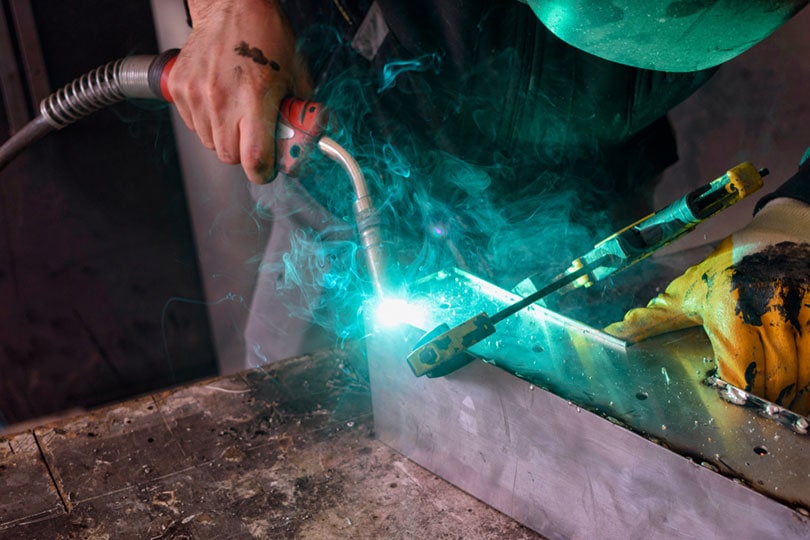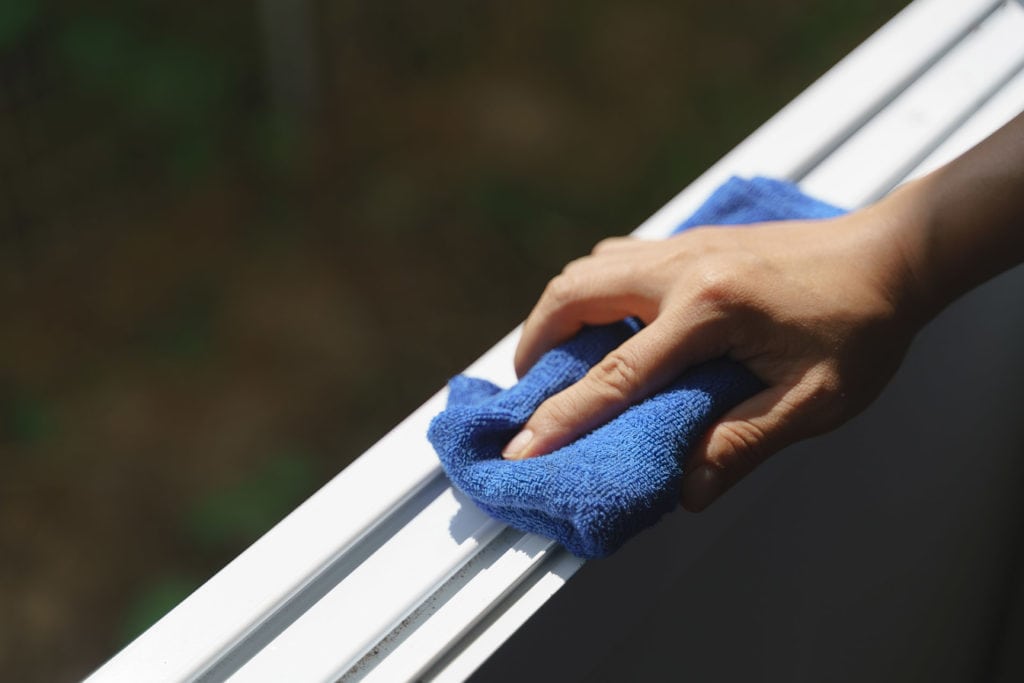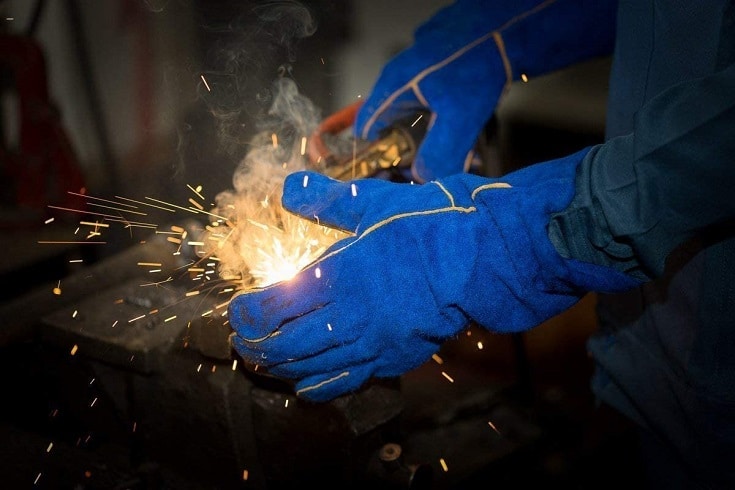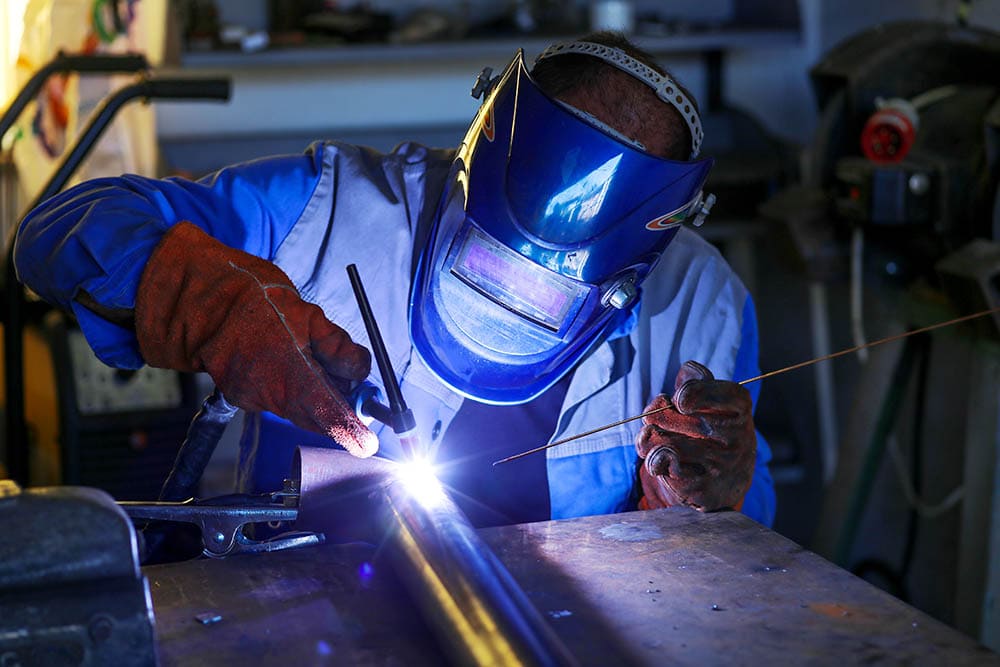How to MIG Weld Aluminum: Full Guide with 15 Tips & Tricks
Last Updated on

Metal Inert Gas (MIG) welding is one of the most popular and utilized welding techniques in the welding community. It is an ideal method for both professional and hobby welding because it is versatile, strong, and easy to learn. It is also a great method for welding aluminum.
Aluminum can be welded to other metals using MIG welding machines with a pulse function and an aluminum alloy wire. This method is especially suitable when you need a high deposition rate, and the base material has a plate thickness of 14 gauges (5/64 inch). If the material is thinner, consider switching to TIG welding.
MIG welding aluminum is, however, not an easy endeavor to undertake. This method poses several challenges that can make it seem daunting to anyone attempting this process for the first time. It requires specialized technique and welder settings to compensate for aluminums’ susceptibility to various deformities such as cracking of the weld.
Fortunately, with the right information, you can smoothly MIG weld aluminum whether you are a novice or an experienced welder. In this article, you will learn why aluminum is such a challenging metal to MIG weld, the process of MIG welding aluminum, and the tips and tricks you can employ to successfully MIG weld aluminum.
Why is it Difficult to MIG Weld Aluminum?
There is a huge difference in the techniques used to MIG aluminum compared to steel. Aluminum has unique physical and chemical properties, making the melt highly susceptible to welding defects that can weaken the weld. Fortunately, with the right tools and techniques, you can easily prevent deformities and produce a strong durable weld. These properties include:

Low Melting Point
Aluminum has a melting point of approximately 1,220 degrees Fahrenheit. Also, when aluminum has undergone oxidation, it melts at just 3,700 degrees Fahrenheit. When compared to steel whose melting point ranges between 2,600 to 2,800 degrees Fahrenheit, aluminum has an extremely low melting point which makes it difficult to work with.
Therefore, the aluminum pieces must be thoroughly cleaned first to remove the protective oxide before attempting any welding.
Metal Thickness
Aluminum metal pieces are often thinner than other melts, such as carbon steel. So, when MIG welding this metal, welders are likely to experience burn-through. This is a common welding defect in aluminum metals, which can easily rack up your welding bills if caution is not exercised.

High Porosity
Aluminum is very sensitive to impurities because it absorbs hydrogen when heated to a molten state. When the melt is cooled back into a solid-state, hydrogen tends to separate from the melt component. This consequently creates bubbles that make aluminum porous. When welded with other metal alloys, the bond created is weak and cannot withstand the test of time.
Highly Sensitive to Impurities
Aluminum welds are highly susceptible to contamination from impurities such as moisture, dirt, and debris. Therefore, MIG welding aluminum requires special care and attention to prevent contamination which will eventually affect the strength of the weld. Ensure that you use proper shielding gasses and filler materials to prevent contamination.
Process of MIG Welding Aluminum
1. Clean the Aluminum Surface
The first step of MIG welding aluminum involves cleaning the surface of the metal. This process is crucial as it allows you to vastly reduce contaminating agents such as dust and moisture from the environment. These impurities would otherwise weaken the weld. The best way to clean aluminum surfaces is using solvents.
One such solvent is acetone. This liquid is an ideal choice for clearing out water vapor, cleaning grease and oils from the surface of the aluminum. You need only apply acetone on a shop towel or a wet cloth, then thoroughly scrub the surface of the aluminum.
Strong soap varieties, such as Oil Eater and degreasers, are also great alternatives for cleaning the metal. Once satisfied with the process, ensure that you rinse and dry the aluminum pieces before welding.

2. Scrub Off Oxidized Layer
As aforementioned, oxidized aluminum metals have a higher melting point compared to the cleaned metal. The oxidized layer will not melt until 3,700 degrees Fahrenheit. So, remove the protective layer before MIG welding aluminum. You can simply remove the surface oxides of aluminum using a stainless-steel wire brush.
However, before scrubbing off the oxidized layer, first, remove contaminants using a degreaser. Failure to, you will likely force hydrocarbons and other contaminants into the metal while scrubbing. Also, removing the oxidized layer using a wire brush is not recommended for inexperienced welders.
You can use oxide-removal solutions as an alternative method of removing oxides from aluminum. However, be very cautious when using these chemical solutions because when used in excess, they can damage aluminum.
3. Choose Proper MIG Welding Filler Material
There is a variety of welding wire electrodes retailing in the market. So, you need to take the time to consider which variety best suits your welding needs and preferences. MIG welding aluminum requires a specific class of wire electrodes designed for exactly this process. The special design prevents defects such as porosity, commonly associated with welding aluminum metals.
The best filler materials for MIG welding aluminum include ER4043, ER4047, ER5183, and ER5356. The ER4043 and ER5356 are the most common and readily available electrodes retailing in the market.
On the other hand, ER4043 is best for auto collision repair jobs because it’s significantly softer than ER5356 electrodes. Your choice of filler materials will ultimately depend on the specific type of base material you are welding. You can consult aluminum filler alloy charts if unsure of the choice to make.
https://www.instagram.com/p/CR6KgwolKhj/
4. Select Shielding Gas
Selecting the shielding gas to protect your weld is a crucial process when MIG welding aluminum. These gasses protect the weld from contamination by common gasses occurring naturally, such as hydrogen, oxygen, and nitrogen. Failure to select a proper shielding gas, your weld will likely be affected by high porosity caused by the existence of gas bubbles on the weld.
Some MIG electrodes, such as flux core MIG wires, do not, however, require the application of a shielding gas but in normal circumstances, many electrodes require gas to reduce the chances of impurity formation on the surface of the aluminum.
The most used gasses in aluminum MIG welding are pure argon and an argon-helium mixture. For thicker sections of aluminum, you can combine both helium and argon. Oxygen and carbon dioxide gasses are, however, not good alternatives because they would likely oxidize and damage the melted weld.
5. Preheat the Metal
Preheating aluminum pieces before welding is a great way to prevent weld deformities. It may not be a necessary step, but it will help reduce the chances of welding cracks occurring on aluminum welds. However, ensure that the temperatures never exceed 230 degrees Fahrenheit.
You can enhance the preheating process by putting track welds before and after the weld zone. Preheating is especially necessary when dealing with thicker aluminum sheets. There are very high chances that common welders may not generate enough heat to weld thick aluminum sheets. In such a scenario, consider using induction heaters for the preheating process.
Induction heating systems are some of the safest and most reliable equipment for preheating aluminum metal sheets. These heaters are made up of a series of heating coils. Since these systems don’t use an open flame, it is easier to control the temperatures generated compared to using a torch.
Our 15 Tips and Tricks for MIG Welding Aluminum
1. Use appropriate filler material.
The best filler materials for MIG welding aluminum include brass shim stock, bronze wire, nickel silver sheets, and copper brazing. These materials can be combined with consumable wire electrodes, especially when making T-joints without backing bars. These filler materials are stronger than mild steel, offering better protection against deformities such as cracking.
2. Preheat your material.
Though not a necessary procedure, preheat thoroughly before attempting MIG welding aluminum to prevent chances of thermal shock on thinner sheets of aluminum. Preheating also prevents warping in thicker aluminum sheets.
3. Shape welding beads.
For a smoother weld finish, consider shaping the weld beds by selecting suitable filler materials. This will increase the durability of the weld by preventing issues such as cracking.
4. Clean finished welds.

Ensure that you clean the MIG welded aluminum joints by using a wire brush or sandpaper. This ensures that the welds don’t flake over time, which could cause corrosion of the metal.
5. Use proper Joint design techniques.
When joining metals with differing metal qualities, ensure that you select the correct joint design methods to reduce the chances of oxidation and corrosion.
6. Proper protection.

When welding aluminum, ensure that you wear long sleeves to protect your hands from MIG welding-related injuries. This method uses shielding gasses that can be irritating to exposed skin. So, you need to cover up before attempting this process by using heavy-duty welding gloves and a jacket.
7. Use an aluminum wire brush.
Aluminum wire brushes are the best tools for getting rid of any rust that may have formed on the metal before welding. This is a crucial process, especially when using filler materials with high levels of iron.
8. Remove oxidation.
Even if there are no visible signs of corrosion on the aluminum’s surface, always scrub off the surface layer of the metal to remove potential oxidation before welding aluminum.
9. Select appropriate nozzle.
Good welders should be able to mix shielding gasses for you. However, ensure that you use the appropriate nozzle that your machine is set up for. If you use, say, a larger nozzle, the machine will likely create a lot of turbulence which can cause arc stability issues.
10. Use a high-frequency start with an inverter.
Experts recommend that welders use a high-frequency start with an inverter when MIG welding aluminum. Failure to, you will likely get poor results welding joints.

11. Remove wire after welding.
Immediately you stop using the gun trigger, remove all the feeder wire starting from the tip. When a wire is left inside after you have stopped welding, it is likely to get colder, which will consequently create a spatter inside the weld puddle.
12. Use higher voltage for better penetration.
When you use higher voltages, you penetrate the material more easily preventing porosity in the weld. The penetration is 50% more than you would normally use. So, make sure that you decrease the voltage to prevent accidentally burning through the metal sheets with excess heat.
13. Use the cloth as a ground clamp.
In case you experience spatter issues in your weld, try using a cloth as a ground clamp before pressing down to clamp. This creates enough drag without necessarily getting hot enough to melt the base material. This would have otherwise created surface tension issues. So be careful where you touch.
14. Select correct driver roll.
This is a crucial consideration because if you don’t select the proper driver roll for welding aluminum, you will likely experience poor feed speed, and wire feed, and get excessive spatter on your weld.
15. Maintain a clean work area.
Always maintain a clean work environment when MIG welding aluminum because when the dust produced is mixed with oxygen, it can be explosive. Even the tiniest of sparks would set it off. Cleaning the work area has myriad benefits, including reducing contamination and extending the electrode’s lifespan and the porosity in your welds. Also, it will help protect you from harmful vapors generated while grinding.
Final Thoughts
As you may have gathered, MIG welding aluminum can be a very tricky affair. Aluminum is a difficult metal to weld because of its chemical and physical properties such as high porosity, low melting point, thin metal sheets, and high sensitivity to porosity.
However, with enough information on the welding process, tips, and tricks, you can successfully produce clean, strong, and durable welds. Fortunately for you, we have put together 15 tips and tricks to assist in aluminum welding aluminum. We hope this guideline will come in handy when welding aluminum using the MIG method.
Featured Image Credit: aydngvn, Shutterstock
